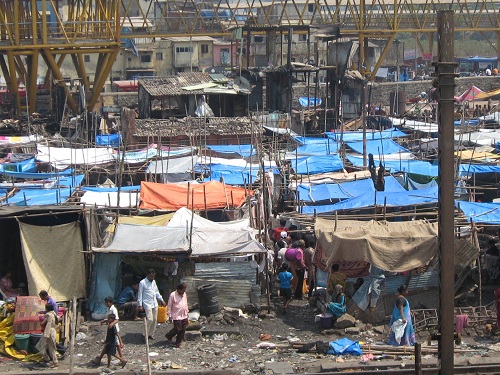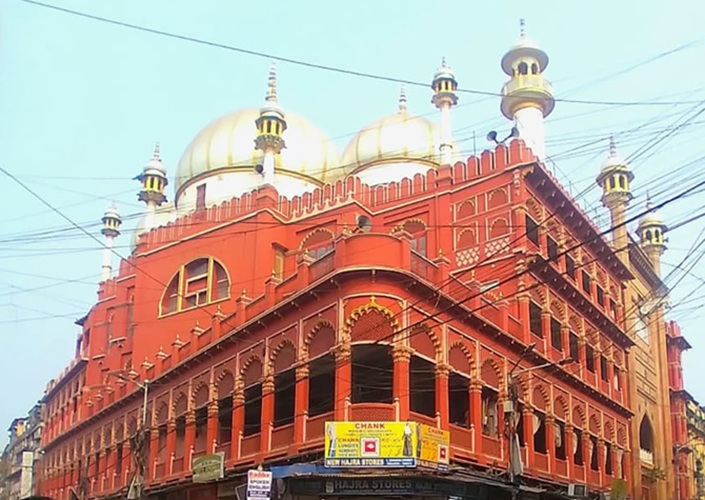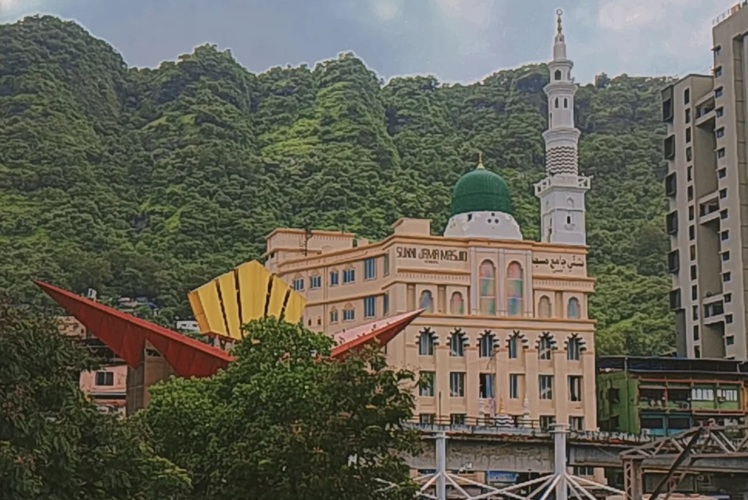By Danish Reyaz
To live in an irredeemable world is the same as living in hell. Nargis Dutt Nagar located near the most happening state-of-art new landmark of Mumbai, Bandra Worli Sea link is a mess, so is the prosaic world in and around. “Its f****** weird, obnoxious, what a blot on the face of this city” might go an expression of a man sitting in chauffeur driven E-calss. To sit on the edge of this newly opened Sea bridge, a modern marvel of India adjacent to the slum- and inhale steam of putrid “toxic “ winds blowing from the filthy, stinky rooms and streets of the locality.
Named after the legendry yesteryear Hindi film actress Nargis, wife of the late Sunil Dutt and mother of ‘Munna Bhai’ Dutt and M.P Priya Dutt, this “Khuda Ki Basti” is a much worse slum area of 1408 hutments than other slums stretched out across Mumbai. This colony is most prone to any kind of epidemic, monsoon related ailments and lacks basic and “very classic” civic amenities like clean drinking water, toilet, garbage disposal system, schools and hospitals. People living in 8×5 and 6×4’s gloomy room in a two, and if sometimes even three storied “Maaliya” hide their growing worries, uneasiness and apprehension behind an air of insouciance.
A 39 year old local social worker Iqbal Dada Mian Shaikh, who is living here with his two wives and 5 children since 1988, tells TSI “When I came here, there were only 40 families. After the demolition of Babri Masjid in 1992, riots erupted and engulfed the whole city. Riot affected people came here for shelter and became part of it”. He further said “when two people of this locality Abdul Qadir Quraishi and Abdul Jhaduwale found allegedly involved in 1993 chain bomb blast, Hamaari basti badnam ho gai (Our locality got a bad name).” Locals told TSI that in the same year some people tried to set the area on fire twice and that caused serious damages to the most hutments but they didn’t evacuate. Iqbal adds “But the fire, broke out on 8th December 2004, was the most catastrophic and reduced the whole area into ashes”. Former M.P of the area, late Sunil Dut and Local MLA Baba Siddiqui came for the rescue and constructed 222 concrete hutments. Now the population has crossed 10,000 and still absorbing the influx of new “refugees”.
When asked why it is a preferred heaven after so many heartbreaking incidents of fire and demolition, Iqbal replies “There is no place to live in Mumbai. You can’t build “Jhopda” without the support of BMC and Police Officials. 70% people have ration and photo ID cards. How they got it only officers can tell you.” Well, this no rocket science, in Mumbai, money can get you anything, ranging from old dated ration cards to passport. To keep a check on mushrooming slums in Mumbai, State Government had passed a regulation making the Area Officer accountable for any new illegal hutments. How many Officers have been punished? No one knows because there is no such data available with BMC.
Adjacent to Nargis Dut Nagar there is another locality, Santosh Nagar. This 40 year old slum has 400 rooms and the population crosses the mark of 4500. An aspiring cricketer Mukul Sinha, who plays for Mumbai belongs to the second generation of this locality, said “This is a heaven and we love to live here”. He adds reluctantly “Of course we face many problems here, but I have grown up in this locality, but it is heaven.” He said that with the help of Government officials and local Dadas (an old Mumbai slang for hooligan, the new word is Bhai) not only steal Reliance electricity but avail all those primary documents for Rs. 1000 to 1500 which government doesn’t issue without getting the facts properly checked.
Sunil Pawaskar, a social activist of Shiv Sena shares his views and experiences with TSI “In fact MAHADA officials are responsible for these illegal slums. Many Bangladeshi immigrants live here illegally, who is responsible for it?” Pawaskar has a different reason to tune his lament “Think for a while when people come to see the sea-face, they are bound to see these unhygienic slums and they don’t feel good”. According to Pawaskar, Nityanand Nagar consists of 500 hutments and Shastri Nagar has approximately 5000 population while in Raju Nagar more than 10,000 people live in 260 hutments. These slums are money minting machine for corrupt officials and bureaucrats and have been converted into epic centre of illegal businesses. On the other side, politicians use and some time “abuse” slum dwellers as vote bank but never work on ground level to address their genuine problems.
Behram Nagar, Bandra, is much lesser in density comparison to Dharavi, but the huge fire broke on 18th June 2009, killing 18, and leaving 738 people on footpath, literally, had attracted not only the government but also a huge number of social workers in the area. Media presence has elevated the matter further. Locals call this fire a handy work of the builder lobby whereas the official line is a short circuit, as always. One and half month after many mini-headlines in the newspapers, they are still at the mercy of the NGOs. While talking to TSI, Mohammad Ali Babu Bhai, 65, who saw rooms of his three wives burning, said, “Fires do not break on its own, nor do we burn our homes, it is the handy work of builder lobby which uses gunda elements for this work.” He remembers that ill-fated night, he said, “That night the houses were locked from outside so that the fire could not be controlled immediately. The idea was to gulp the entire Behram Nagar.”
It houses more than one lakh people out of which 27,000 are voters. In the name of basic facilities, this area has a rationing shop which was opened here in 1950. This was a piece of land gifted by Rani of Baroda to her most loyal and trusted man Behram in 1810. People have started to come in here in 1930. Claiming to develop this area into a Basti with his own hands, Ahsan Khan said, “We filled this entire area for only Rs.300 and Additional Collector P.K. Date had allowed 868 people to live here. But later on, people from UP, Bihar and South India started to join in and soon the population crossed a mark of many thousands.” He had worked hard for Worli Metal Box Company and started Qaisar Education society which later started Behram Nagar’s first Degree College. He said, “I am not educated. I wanted other children of the locality to get educated along with my own children. So, I started an educational society which is now a degree college. It has government’s grant.” He opens his heart to other problems faced by him and people like him, “But now the builder lobby wants to evacuate people from this prime location. They want to develop towers here by burying us all under it.”
It is the fact of the moment that the nexus between the politicians and builders are proving fatal for 61% of the city population who are living in slums and kachchi aabadis. Multi-national companies are just proving to be giving a powerful hidden hand to the whole lot.
More than 14 national and international companies had submitted their tenders for the redevelopment of Dharavi. Maharashtra government is party and also bidding to win this redevelopment. Small and medium size builders are happy doing their small projects through SRA schemes.
Making a serious allegation on Dewaan Builders, who had developed areas around Behram Nagar, Shakira Iqbaal said, “People of Deewan builders wanted to demolish the houses. We wanted a good compensation for a place where we lived and make it our own in so many years. When things did not get materialized, he had started to create communal tension in the area.” According to her, “Deewan himself is a Muslim but he made his people pelt stones in the mosque so that the atmosphere got tensed.” A very serious allegation indeed. Timely interference of the police had averted a possible communal clash in this very sensitive area.
It is not slums, but even the mentality is also not changing. There is hardly any will amongst majority of slum dwellers to move out of their filthy world. Mohammad Yusuf Attar, Chairman of Synaloge Foundation, which teaches computers, said, “I am working amongst Govandi and Shivaji Nagar slums for many years but I am not able to change their mentality. Students, mostly drop-outs and poor, come from these areas, train under me, go out as computer hardware engineers and find good placements. But when they receive their first payment Rs. 4000-5000, they make faces saying that they could earn more money by only fetching Kachra.” He feels that a basic change in the mentality will create a huge change.
A little away from MHADA head office, barely few furlongs away, situated Kherwadi, which is one of the oldest slums of Mumbai. Lakshman Nehalchand Daema, 82, watches carefully, at least he seems so, everyone passing from this old Bhumiya temple, constructed in 1911 by Khatik Samaj. Nothing has changed for him. He said, “I live here for more than half a century, but as a slum dweller, nothing has changed for me.”
Narrating his little story of Kherwadi, he said, “When I came here, it was all jungle. There were only 16 Jhopdis which was occupied by the people of our Khatik Samaj. When Bal Gangadhar Khed became minister of state, he visited this place and saw us, Adiwasis, living in a bad condition. Then he provided us roads and other basic amenities.” People realized his services for this area and named the entire area after him.
Being an economic capital of the country, Mumbai is still the most attractive address for migrants, job seekers, dreamers and that is multiplying the population of these slums, these are glaring examples for this new burgeoning trend. In comparison to the Delhi and Chennai they have less economic status. Only 14.8% live under A-class in Mumbai while the ratio in Delhi and Chennai is 25.4% and 16.3% respectively. More than 60% population of Mumbai lives in slums, in which 25 to 30 % people live in Chawls and on edges of footpaths. Only 10 to 15% of the whole population lives in buildings and bungalows. The government’s wild claim to convert Mumbai into Shanghai sounds, in people’s view, tuneless.
Assistant Administrative Officer of Slum Rehabilitation Administration (SRA) department Ravindra Vidiya said, “You don’t know when and where slums can rise in Mumbai. We come to know about it and its history only when Government or the people of this area come to register their hutments under SRA schemes”. He further told that only hutments set up before 1st January 1995 comes under SRA scheme. We provide them houses after redeveloping the area. Public Relation Officer of SRA Chandra Kant Kotemkar told that keeping the huge quantity of applications Government established separate departments like Dharavi Development Project etc.
The political atmosphere is once again very hot and the heat is provided by the present Congress led Maharashtra government which has announced to legalize slums constructed on or before 2000. Shiv Sena had termed and rejected it by calling it an election stunt. It has also threatened to hold the bull by horns. There is a section in the Congress party which opposes the decision made by Chief Minister Ashok Chavhan. Congress state minister of industry Narayan Rane and Ajeet Pawar, NCP, minister for Water Resources, lambasted the move and call it a politics of vote bank. Rane has opposed the move in the cabinet meeting and said, “By legalisisng the illegal slums, we will complicate the situation in Mumbai even further.”
Well, the problem of Mumbai is not going to be solved anytime sooner. On one hand, it is dreaming to become Shanghai, and on the contrary, majority of this financial capital of developing India lives in either slums, or on the footpaths. By legalizing slums, for whatever gain, political or otherwise, and shying away from the real problems will only increase and complicate the situation. It will not only create social unrest but open a Pandora’s box.
Interview, Vinod Popatlal, Former Deputy Mayor, Mumbai
Q: how do you look at the new slums and SRA schemes?
A: Today, I feel that because of the SRA schemes, problems are increasing. Actually, after 1995, there is an increase in land grabbing. Every year, norths Indians are growing by a huge margin. People from Pratapgadh, Gorakhpur and Azamgarh etc. are coming to the city every day and we are providing them with free land. When you distribute things for free, many will come to grab the opportunity. SRA is doing exactly the same. And this is primarily for this reason that the slums are not vanishing, rather increasing in the city.
Q: Occupants of illegal structures posses everything, right from ration card to election cards, how do they manage all this when people like you are in the power?
A: Actually, whoever comes to power, he opens these illegal doors for one reason or the other. When fake currencies of Rs. 500 are being printed here, then these are just small things.
Q: what do you think is the solution to all these problems?
A: Our honesty and righteousness is at stake right now. Corruption had created a ruckus all over the place. If we perform our duties honestly, we will end up breaking our own house, destroy our own party. In fact, this is the biggest weakness of democracy, that we only count heads, and not the origin of it or the body which is carrying it. In many places, we had seen that husband and wife have separate jhopdis in their respective names. When we investigate and find it, they say, ‘we are divorced.’ But the same pair keeps giving birth to children. They live together and avail all the possible facilities from the government. They live separately to maximize the benefits. If you don’t change the mentality, of those who are in power and of those who live in slums, nothing could be said with confidence.







0 Comments